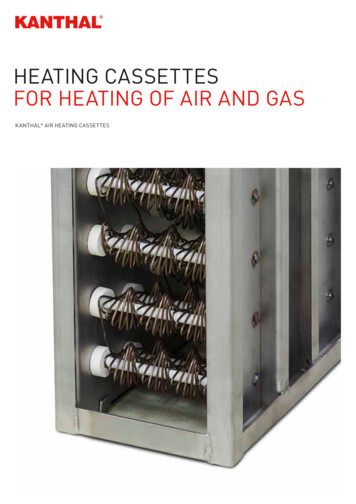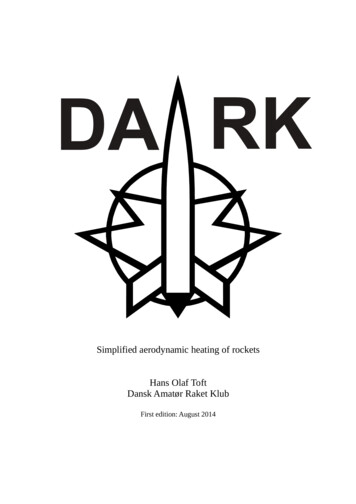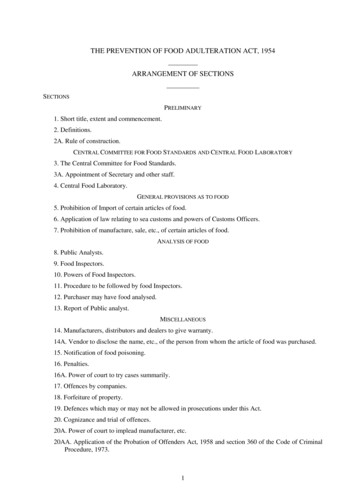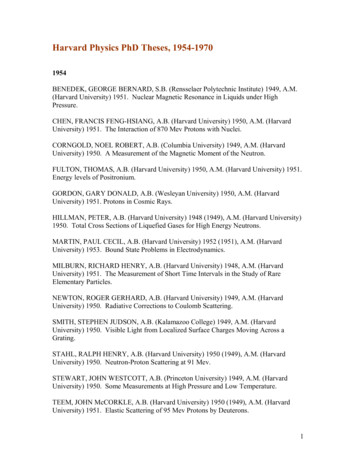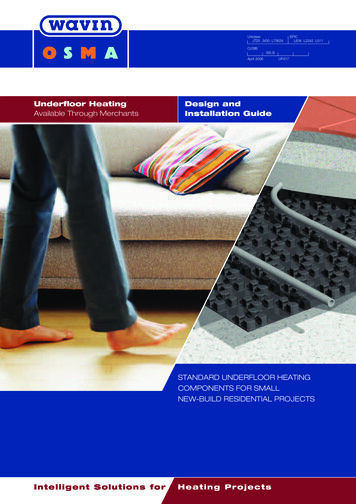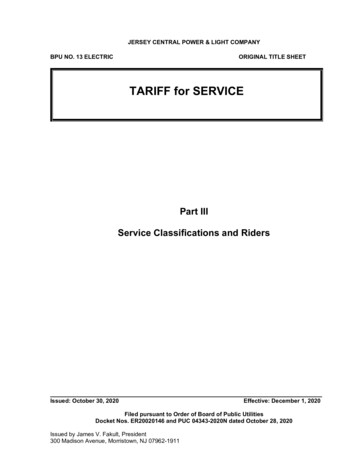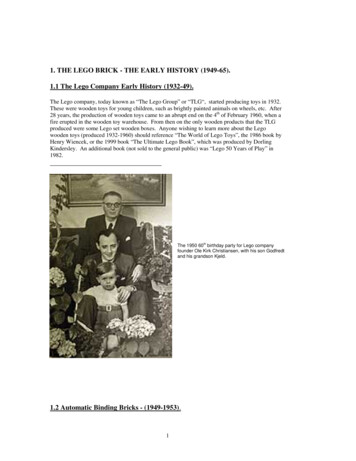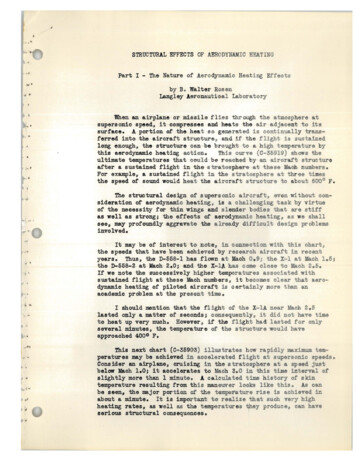
Transcription
. 'STRUCTURAL EFFECTS OF AERODYNAMIC HEATI NGPart I - The Nature of Aerodynamic He ati ng Effec'cs.,." I' I."." l'. ,.,. ., '" - .(of. '",.by Bo Walter Ros enLangley Aeronaut i Gal LaboratoryWhen an airplane or mis sile l i e s through t he atmosphere a tsupersonic speed» it compresses and heat s the air a djacent t o itssur ace.A portion the heat BO generated is continually tran erred into the aircraft str uc ture D and :i.f t he l:i. ght is sustainedlong enough, the structure c an ·be brought to a h igh temperature bythis aerodynamic heating acti ol1oThis curve (C-35919) shows theultimate temperatures tha t coul d be r ea ched by an a;i.rcraft strueture ter a sustained light in the stra tosphe-r e at these Maoh nwnber8 0For example p a sustained light in the stratosphere at thr. ee timesthe speed of sound woul d h eat t he a i rcraft structure to about 600 0 F The structural design o supers on:i,c a ircraft,9 even without con sideration o aerodynamic heating9 is a challeng ing task by virtueo the necessity or thin wings and slender bodies that are s 'tiffas well as strong j the e fects of' aerodynamic hea t ing D as we shallseep may profoundly aggravat e the already di ff icult design pr.oblemsinvolved It may be of interest to noteD in c onne ction with this chartsthe speeds that have been achieved by r es earch aircraft in recantyears 0 Thus, the D-558-l has flown a t Mach 0 0 9» the X l at Mach l u 5 the D-558-2 at Mach 2.0 and the X 1A has come close to Mach 2 ,., 5 0If we note the successively higher temperatures ass ociated withsustained flight at these Mach numbersD i.t b ecome s clear that aero dynamic heating of piloted aircraft i s c er t a inly more than anacademic problem at the present t ime I should mention that t he light of t he X lAlasted only a matter of secondsj consequentlYD itto heat up very much. However D U the light hadseveral minutes 9 the temperature 01' the structureapproached 400 0 F near Mach 205did not have timelasted or onlywould havei'his next chart (C 35903 ) illustra tes h ow rapidly maximum tem peratures may be achieved in acc el e r a ted f light at supersonic speed.s 0Consider an airplanel oruising in the s t ratosph ere at a speed justbelow Mach 1.0; it accelerates to Mach 30 0 in this time interTal ofslightly more than I minute o A c a l oulated time h istory of skintemperature resulting from thi s man euver l ooks like this 0 As canbe seen, the major port ion of' the t emper a ture rise is achieved inabout a minute. I t is impor t ant to r ealize that such very highheating rates, as well as t he t emperatur es they produce D can haveserious structural consequenceso
,oj- 2 . .". .A.j. (, ,. . -. - 1 . .,.J."". The major structural eff-ects of high temperature and l"8,pid heat ngwill be shown on this chart (C 35918)" (Illuminate part 1 of C-35918 o)The primary effects r:sf higher temp-era-ttno-es emst:rucirural 'lIla:te1"ialsare to redaee their strength and s·tif'f'n:ess properties II and to makethem subject to creepo that isDa ·g :radual and perman-ent increase indeformation ·u nder constant l oa.d o The aircraft des igner is faced.with the necessity of ohoosing a structural mat erial that is mostefficient for the rflllg8 of t-emperatures at which the aircraft isintended to perform. For example II analytical studies have yieldedthe results shawn on this chart (C 35904) f or the best material touse in the skin of aircraft struc tur es desi.gned to operate in variousMach number ranges. It appears t hat aluminum loses its n .peri.ol' i tyas a plate material above Mach nUl!ber 2 .0 around Mach 300 .!) titaniumis the most efficient material for still higher MaCh n umbers v andtheir correspondingly higher temperatures l) s t eel is best o HONe'Ve:t'l)even with the use of the most efficient material ,!) OTf!lep dis ·to rt.;ion will occur at elevated temperatures l) and th e possibility of exc619Sivedeformation due to oreep JIIl.UJ·t be t aken into a.cCOUIl.t in the der:d.gn ofthe airoraftoThe effects or rapid heating (illumi.nate part 2 of C 35 9 l8) areperhaps equal in importance to those of high temperature. (Exti:ogubhpart 10) When a structure is subj ected. to rapid heati.ng D the te perature in the structure var:i.es widely f rom point to poin'!'; ,!) at leastin the initial stages of heatingo Such non uni form temperaturedistribution gives rise to s·tresses o These therma l stresses may haveserious structural oonsequenoes o I will now demonstrate S or theadverse struotural effects of thermal s tresses produced by rapidheating.Thermal stresses may a ttain magn i tudes suff icient to causebuokling (illuminate "BuokUngD 98 par t :5 of O 359 l8 ) of the su.rf'aceof the airoraft. Suoh buokle formation will be demonstrated wi.ththe aid of this heating apparatus ( on wal l " left oenter) 0 Theapparatus consists of twa identi nal banks of high intensi'ty quartztube heat lamps with tungsten filame:c:ts o The heaters will be usedto apply a rapid rate of heating t o this small soale test sps·l)i.menwhioh represents the skin and spar struoture of an airplane wiDg "One side of the skin has been painted b lack to increase ·the rate ofheat absorptiono Note that the surfaoe of the specimen is f'lat o(Insert specimen in heater .) The heating will take plaoe 1.'or ofi,lya few seconds.14'(.""" '.;.1.(Heat speoimeno Explain that smoke is caused by burni.:cg of theblack 1acquero RemQVe specimen and h old it f or audience to see o)As you can see» the skin new contains buckles!) caus.sd by thethermal stresses that result ed from the rapid beating to which thesurface was subjected. Such buckles l) occurri:cg at high supersonicspeed, would not only have adverse aerodynamic effects l) but couldalso preoipitate destru tion of the air craft o (Extinguish part 3of C-35918.)
.' .; .-.!4.,. . .-".t1"' . , ,, y. ./"'1. .« . . J 6 - We have just s een how a wing structure 9 s ubjected to conditionscomparable t !l thos"8 wh i ch would be expel"ienced in supersonic i'light vwas destroyed as a resu l t oi'some of' the adverse structural ei'i'ec sof aerodynamic heating which we have been discu ssing oTh far, we have been c onc erned with problems of aerodynamicheating associated with a:ir craft that fl y i n th i s s peed range (pointout Mach nUDiber range on ab s c issa of C- 359l 9) 0 In general ,!) :Lt. i sexpected that these will be a ir craft which us e engines that obtai.ntheir o:x;ygen from the earth ys atmosphere,!) or t h ey may be sh orle·range srocket-propelled mis s iles oThere . ares however,!) other rocket propelled miss iles which il1fly at mu.ch higher speeds o These are the l ong range missiles of ·theso-called ballistic typeo Ballistio missiles are projected rapidlyout of the earth v s atmos phere and af' ter their f uel is exhaustedthey follow the path of a fre e projectile o This chart (0- 35922)shows typical traj ec t or i e s of thr ee ballistic missiles o The rang eDor distance, that is traversed by a ballistic missile is dire tlyrelated to the speed a t tained by the mis sile during the r el ative l yshort time in which propellant fuel is burned o The s peeds associatedwith ballistic missiles of t hese ranges (p oint to abscissa values)are indicated on each or the traj e ctories o For example,!) a ballisticmissile with a range of 3000 nautical miles would be accelerated toa speed of about Mach 20 in the ini t ial p art of its trajectory o A2ithese freely falling mis s iles p lummet toward the earthl) they re enterthe earthYs atmosphere at extremely high speeds which result in hightemperature g as shawn on t his chart (0 3 59l7) o For example 9 in · espeed range from Mach 5 to lOs fl i ght in t he atmosphere could produce 'temperatures ranging f r om 2000 0 to almost 8000 0 F eThis lower speed rang e (point out shaded area of C 359l7) isthat whiohwas discussed in connection with the aerodynamic heatingproblems previous l y described and demonstratedo These same pro'blemsexist!) and indeed can be more s evere ! f or s h ort time i'l ight at thesehigher speedsG In addit ions at thes e higher MaCh numbers associatedwith the ballist i o type miss i l e s sus t&ine d f light in the atmospherewill produoe temperatures su.f'f icient t o melt the v·ari ous met a ls ah owl!hereo At the temperatures attainable ab ove Mach 10 1) diamonds vapori:t:eand, indeed, no pres ent ly known materia l cou l d exist in the solidstate 0 Thus!) at the se higher Mach numbers s the very physical existenceof an aircraft structure is threatened by the heat to which i.t wouldbe subjeoted I wish to emphasize that the serious and compl e x structuralproblems which we hav e been dis cussi.ng occur at temperatures wellbelow these which cause the me l t i ng of matalso However ! inasmoohas the possibi lity of me lting does exist, f or examples at the noseof a missile if the time of flig h in the atmos phere is long enough! a test was oonducted for t h e purpose of observing the nature or such
J 1.'.'- 7 melting action. A model of a mi ss ile no se wa s made of a low"'me l t ing point alloy and was tested in a wind tunne l at high su pers on ic s peed We will now show a motion picture of that test. (Movie on. )Commentary on motion picture of melting missi l e nose:Note sharp point on missile modelPointer indicates temperatlrre in 100 0 FPoint of missile melts and nose bec omes more b luntMelted nose is approxiImte ly hemi sph ericalMelted material flows back and is then carri ed away i nair streamThis concludes the Langley le.bora.tory pre s en t a tion o.,.Descripti on of Ch art sC-35919. Title Temperature Atta inable i.n Sus tained Flight .Temperature in of is plotted vs. Mach number t o spee d of M 4.On this chart models of D-558-1, X-l D-558-LL and X-IA are pl aced., y .," ,.,,(. ,"'C-35903. Title Tempera.t ure History. On the upper half of th e charta curve of Speed p M vs. Time , Min., was sh own f or an a irp l aneaccelerating from M ::: 0 0 8 to M 3 in about 1 minute . On t h e lowerchart a temperature-tiIre history for the skin is given for the air pl ane .C-3591B. This was a b a cklighted panel wi th s epar a t e U ght i ng c ircuitsfor five items of information. Each i t em was illwn:i.nat ed i n corre l a tion with text.C-35904. Title: Most Effici ent Blade Ma.ter i a l o On cur ve of Tempe ratur.evs. M, shaded portions were marked t o indi c a.t e t he range s O"l.?er wh ichaluminum, titanium, and steel materi a l s woul d b e mos t aff icient f oruse in the skin of an aircraf t .wC-35922. Title: Trajec tories of Ba ll i sti c Mi s s ile s . On a chart ofAltitud I vs. Range i both in nautical mi l es. t r aj ectoria s of mi,3s Ueswith maximum speeds of M ;: 10, 15 , and 20 are gi ven . . ".,.' 4",C-35917. TitIe: Temperatur e Attains.b l e in Susta.ined Flight . Thi chart is an extension of C-35919 to a s peed of M ; 15 0 00. thetemperature curve., mel ting tempe r atur es of sev'eral metals areindicated.
. i.AI".-J ). I.t. .,.]18"Tj[r---1111 JII' ' " I c - jCLjI I I I I I I I I If--.lI I I I I I I II ,I I I I I I II.L.a,.f.1C:JD/8"5 8 "R MOY P oll.,1"''EMoy LJooli! CLOSCR AND /:KJo-, "s7?JPIL l(,"1 9 S 4- INSPECTIONEIGHixSI X FOOT S. S. W.T. OS. ROOM!i' .i , ." . ' . '3"LEWIS FLIGHT PROPULSION LAB.S :ALE:'/ ", 1'-0·LAN G L E YLAB, STOP,d·,1iJ ;;I1 "JJS;"T w 'C T . . .lC " , Pi?oJ cC'TbR. 2 8n.r
Tyy4
·r
IH911 W '033dS ,'.4o "I- OO ----" OOO OOr009008OOO lJo W3 1G3NIV1SnS NI 31BVNIVIIV ,. . .)-.'. , .,)0" .,--.3 nlVM3dW31f". . . . . . .
0OOloar009Jo W]l.--.---.0ll, W'O]]dS
-v--- ,'- Nt«:A"r'!" -i.:".J. ;:,C-35918' r-.6",, '# ,ELEVATEDa.DETERIORATION OFTEM PERATU RE . J MATERIAL PROPERTI ESb. CR EEPRAPID THERMALHEATING- STRESSES-- BUCKLING- REDUCED STIFFNESS. FLUTTER.1t4.
:- ., "' . 1 : · · "('J.'"-1.T., 4.4W 10]] dS l00 009006DOLl.
000 S31lWOOOllV llnVN "3 NVH0001OOlOOv009S31lWlV llnVN"30 nllllVS31lSSIW JllSlllVa :}.: . .1 ,.,",.)1. .f" -. ".':.l": OS31HOIJ3rVHl. "*'J:'r:y.,.r,.f.,.rT«'r- - "--"-'--
S1131 InNllnl'Sllll1131SSlllR IJIOOOr00090008Jo W31
heat s the air adjacent t o its . sur ace. A portion the heat . BO . generated . is . continually . tran erred . into the aircraft str uctureD and :i.f . t he l:i.ght . is sustained long enough, the structure can ·be brought to a high temperature by this aerodynamic heating acti ol1o This curve (C-35919) shows the
